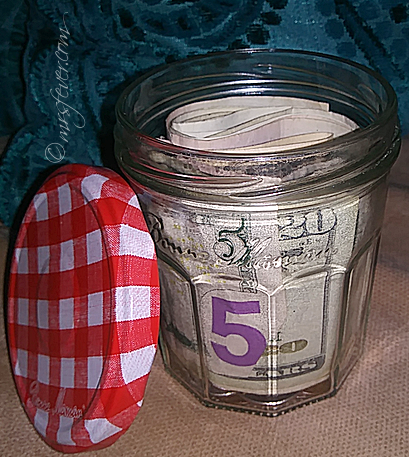
The Money Jar
I’ve talked recently a bit about money — about living within your means (and how you first have to understand what those means *actually* are) without spending every cent you earn and about getting out of debt — and one of the key things involved with both of those concepts is budgeting.
And while there are a lot of things you can do in terms of figuring out your budget and properly allocating funds for necessities, I thought I’d tackle the concept of budgeting on a much more precise and personal level. 🙂
So this post is about our household Money Jar.
What is the Money Jar for?
In 2015, after the Mister and I had purchased the house we currently live in, we took a long hard look at the figures in terms of what/how we spent our ‘extra’ money and decided that we needed to control that spending a little better.
Specifically, we needed to control our “dining out” budget better.
Because…
Well, what can I say? *laugh* We like our food! 😛
But we (‘we’ meaning ‘me’ — I’m the one who manages our money so really it came down to me saying, “This has to change!”) decided that even though we like food, we don’t like how much we spend on food at restaurants.
So we made a plan.
Every week, I allocate money toward dining out. This is separate from our individual ‘mad money’ (which is basically an allowance that neither of us has to account to the other for) but *is* ‘mad money’ of a sort. Because it’s a bit frivolous, right? Like, we don’t have to eat at restaurants.
But we LIKE to.
So in order to do what we like but not go overboard with it, I allocate.
I allocate $50 per week to the “dining out” fund.
(Yes, I realize some of you will say, “My GOD!!!” because you think either {1} it’s way too much, or {2} barely enough to feed a family of four at McDonald’s. But this is my budget, not yours. And my goal with these posts is to be specific, honest, and open about money because vagaries help no one.)
This can be used for teriyaki take-out or pizza delivery, dine-in restauranting (in non-COVID times, when restaurants are actually… y’know… OPEN), coffee shop relaxed-kaffeeklatsch-ing, or ice cream shop treats. The key is: this is money that we use together, for the purpose of ‘dining out’ in some form or fashion, and when the week’s money is gone, it’s gone.
BUT
When the week’s money is NOT gone…
As in: One week — I budget for dining on a Sunday thru Saturday weekly basis — we went out for coffee on Sunday morning and got teriyaki on Friday night but did not go out for any other restaurant foods, so our total spend for the week was only $38.12 (instead of the whole $50)…
The excess/unused-money goes into the Money Jar.
The ‘Extra’
As you can see from the illustration above, those ‘extra’ (unused) monies stack up over time.
We tend to empty the jar at Thanksgiving (third weekend in November, for my outside-the-U.S. blogging friends) and then decide what to do with the money depending on how much is in it.
(What you see in the photo is what has been added to the money jar to date since Thanksgiving 2020.)
Sometimes we use it for Christmas gifts. Other times we use it to buy restaurant gift cards, which stretch our dining-out budget further during the holidays.* Occasionally we pay a bill with it or put it toward an educational expense (college class, workshop, CEU project, etc.). Once in a while we add it to our vacation fund** -OR- if an immediate household-expense type of need arises, we handle it out of that money.
SO
The Money Jar
Easy, peasy.
Practical budgeting hacks from a fiscally-conscious food-loving Feve. 😉
.
Do you have a budget for dining out?
What simple solutions do you use for cash budgeting?
.
*I got real about my actual-numbers budget in one of my recent posts, and restaurant eating was not included in that month’s expenses; this is why — it had already been accounted for
**dining out while on vacation is a separate thing, by the way — we take that money out of our vacation budget


I did the money jar thing successfully many years ago. I also had a savings account but I liked to watch the odd change and other random $$ add up where I could look at it.
I was a dedicated couponer and rebater, plus I’d add whatever change of the day to it, later adding paper change from say, buying a tank of gas w/ a $10, or change from a $20 for groceries. Yes, in those days there might be change from a ten or twenty haha. The money jar ended buying a round trip airfare from DC to Paris !
Oh, how fun! 😀
I allocate cash as an allowance on a weekly basis (usually $15 or $20) and my husband puts his loose change from allowance-spending in an empty water jug. I rolled what I could from his little stash before Christmas (it was only about 20% full) and it netted him almost $100. 🙂
Love the Money Jar concept and also the fact you can see it mounting up really must incentivise you. I think it is important for you to have the “dining out” fund. When they were open! It is a great way of sharing something and enjoying your time together – and probably one of the things keeping your relationship strong.
I am soo happy you suggested the topic of Money to me for #lifematters. The posts are fabulous and really give people something to think about
May x
May More recently posted…Tarot Cards ~ Life stories via Symbolism
Yes, being able to physically *see* money gaining (or depleting, when it’s been spent) is key. I think that NOT seeing that — because of the push to digitize payments and swipe plastic for everything — is why so many people take such a long time to ‘get it’ where spending and saving wisely are concerned.
*shakes old man fist*
: laugh :
(I understand so much better now why the adults that peppered my youth were always so aggrieved by “kids these days!” Lol.)
And yes, we love our restaurant time. Not having that available during Lockdowns has sucked. Where I live, restaurants in some areas were just allowed to open last week for indoor dining (limited capacity, but hooray for wait staff and somebody else doing the cooking!); we went “out to eat” on Friday for the first time in three months. It was lovely.
Thank you for sharing. It’s a wonderful idea! I’ll share something I do –
I have a weird thing where I stash away uncreased bills. This happens a LOT during the Chinese new year period when people use their “hongbao” or “red packets” money after getting all that cash during the new year visiting. (Ok if you’re not sure what I’m talking about, never mind, just go with it… LOL). I receive hongbaos with new bills too, so that of course goes into the stash. And when I go to the shops, for example, and i break a 50, i might get some nice 2 or 10 dollar bills that are in pristine condition, and they get added to the stash too – straight into my drawer for safekeeping.
The following year when I need to prepare red packets to give away I just take the money from this stash. That way i don’t have to dip into my savings or spending money for that month to deal with the extra expense. And when I have extra, which I usually do, I prep mum’s red packets with bills from this stash, and she just passes me the cash directly from her bank account.
So in a way, I’m still saving – for the next year’s red packets to give away, as well as any unused portion (by me) gets swapped with mum and turns into MORE savings in my bank. (Or to pay off things that get paid annually like insurance or subscriptions.)
Oh, that’s interesting!
I like the idea of keeping hold of the pristine money. When I get cash that’s “new” (crisp, uncreased), I’m quite reluctant to spend it. So I definitely understand the psychology there!
Pingback: Budgeting ~ Personal Traditions and Food - SEX MATTERS
We don’t budget for going out for dinner, but we do have a ‘money jar’ in the form of a piggy. It’s a piggy bank I got from my kids many years ago, and it gets emptied more or less once a year. Whenever we need cash for whatever, the spare change goes in there too.
~ Marie
I still have my piggy bank (mine is actually a puppy, not a piggy) from when I was a child. When my wallet gets too heavy with change/coins, I put them in my puppy bank. I usually roll the coins inside once or twice a year and cash them in at my bank. I think last time I did that, I had close to $70.
Pingback: Comparing Costs: Budget Changes in the Time of Coronavirus ~ Temperature's Rising